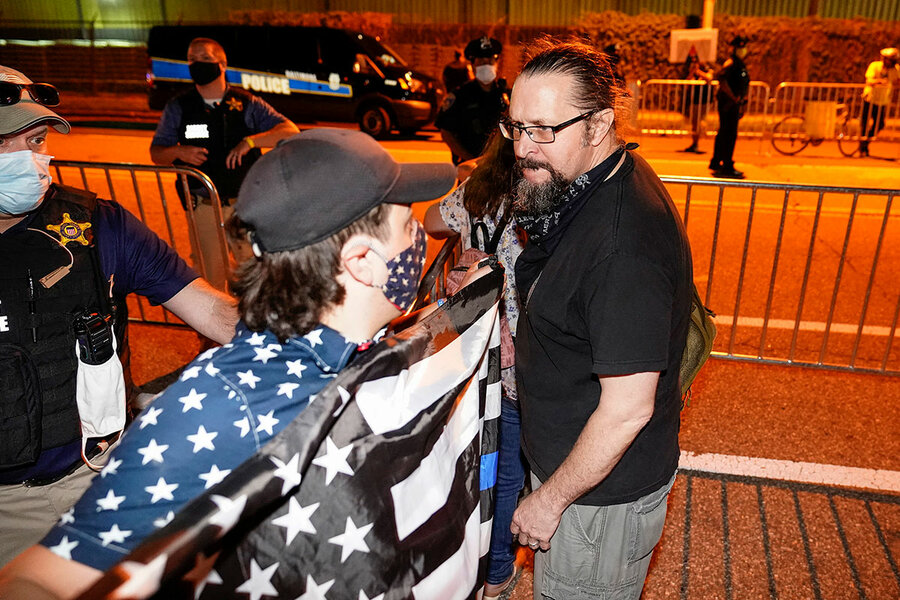Americans are angry about ... everything. Is that bad?
Early this year, country music artists Jeffrey Steele and Aaron Lewis spent hours at Mr. Lewis’ house in Nashville, trying to write a song to their fans. It was going poorly.
Mr. Steele and Mr. Lewis are Nashville veterans. They know how to write songs about summertime and sweet rural life that sell, but they didn’t want to follow the formula. Both conservatives, they wanted a song that would make them feel connected to a community of fans with similar views. Writing one had been hard.
So Mr. Steele looked up something he’d already written on his phone. It was called “Am I the Only One?,” an explicit half-vent, half-lament that America is changing.
Why We Wrote This
Americans are angry, but what are they doing with their outrage? We talk to Americans of all political affiliations who have channeled that emotion in creative or productive ways.
The song is about “that feeling of being the only one sitting here tonight, watching my TV, feeling like the whole world is falling apart,” says Mr. Steele, a conservative Christian. “[Mr. Lewis] lit up on it.”
Released this July, “Am I the Only One?” debuted atop country charts, though some outlets wouldn’t play it due to the edgy right-wing lyrics. The songwriters interpret sales – just under 60,000 in its first week – as a sign that other people share a sense of frustration. While not everyone may agree with his politics, in a broader way, Mr. Steele is right. He’s not the only one who’s angry.
On the left, parts of the public are equally outraged about what they also see as America’s moral drift: They point to a lack of care for one’s neighbor in a public health emergency, the GOP embrace of “the big lie” about the 2020 election, and disregard for the planet amid a climate crisis.
Take a panorama of the country in 2021. The FBI is reporting a rise in violent crime. The Federal Aviation Administration is recording higher-than-ever numbers of unruly passengers. This month, Attorney General Merrick Garland released a memo on threats of violence against school board members. A year preceded by mass protests, marred at times by rioting, began with a deadly riot at the Capitol.
It’s a portrait of an angry nation, and it’s backed up by polling. In early September, almost 3 in 4 respondents told CNN that they felt at least somewhat angry at “the way things are going in the country today.” In January, 54% of participants in a CBS News poll said that the “biggest threat to America’s way of life” was “other people in America” – not economic or foreign threats or natural disasters.
This is scarcely the first year that anger has defined life in America – a country built by revolution. Anger is a complicated emotion. It unites and divides. It fixes social problems and creates them. It led to both the civil rights movement and the Civil War.
But as Americans’ frustrations pile up – from the botched Afghanistan withdrawal abroad to a lingering pandemic at home – the need to cope with that anger rises too. Different Americans might be angry for different reasons, but the need to express it without targeting others is the same.
“It’s sheer frustration,” says Mr. Steele. “I’m telling you, I got so many rocks thrown at me: ‘Jeff, you’ve never written anything like this before.’ I really look at this as like you have an outlet – I’m only a writer, but I have an outlet – so it’s my responsibility to say something.”
American tradition turned partisan warfare
Anger is an American tradition. The country’s founders used it to rouse ambivalent colonists against the British. The country’s great social movements – from abolition to suffrage to civil rights – united around a sense of righteous outrage. America’s Civil War was, in part, the result of regional animosity. America’s most famous sermon, delivered by Jonathan Edwards, is “Sinners in the Hands of an Angry God.”
But the pace of anger has accelerated in recent decades. Partisan sorting, or the tendency of voters to interact only with those who agree with them, has left the country increasingly divided. Cable news, talk radio, and social media often entrench it. It’s now easier than ever to become angry, and easier for political leaders to stoke that anger, says Steven Webster, assistant professor of political science at Indiana University and author of “American Rage: How Anger Shapes Our Politics.”
That cascade “moves us outside a competition of ideas and into the realm of tribal warfare – it’s us against them and my loss is going to lead to some unfortunate consequence for the health of the country,” he says.
Anger makes speech powerful, and powerful speech has its place in politics. That’s been true since Plato argued in the Agora, says Myisha Cherry, author of “The Case for Rage” and a professor of philosophy at the University of California, Riverside. The emotion is an important way to communicate and reflect, she says. Strong feelings make people more likely to change the status quo, say by protesting against police brutality.
Or by storming the Capitol – an extreme example of unchecked, misdirected anger, and a clear sign of its risks, says Professor Cherry. Anger is a way to express fear, says David Rosmarin, assistant professor of psychology in the Department of Psychiatry at Harvard Medical School. The emotion activates the fight-or-flight response, he says, leading people to act on instinct. That leaves people vulnerable, and, in the worst cases, dangerous.
“Is it good anger or bad anger?”
David Grimmett, an attorney in Tennessee’s Williamson County, saw as much at a school board meeting this August.
Almost 2,500 people showed up to debate a school mask mandate. Mr. Grimmett came to oppose it, but with a different tone than some who agreed with him. Anti-mask chants outside were so loud he could hear them through the building’s walls. The board received verbal attacks and threats following the meeting – part of what led the Department of Justice to release a memo on the risk of violence against school boards and teachers.
“At the meeting, out in public, we had some people who were very, very logical, methodical, good speakers, and then other people who were attacking the board members,” says Mr. Grimmett. “That’s the problem: when it comes out as an attack versus a public discourse or disagreement.”
The mask mandate eventually passed. Mr. Grimmett accepted the loss, in part because he understands both positions: guaranteeing protection for others versus allowing parents to decide what’s right for their children. But that’s an emotional debate, he says, and he can also understand why parents could get angry – up to a point.
“It comes down to whether it’s good anger or bad anger,” says Mr. Grimmett. “In these types of situations, do we believe that people are hearing us when we are angry? It’s OK to be angry. If you bottle it up, it can just explode.”
“Driven by what’s supposed to be”
A year earlier and hundreds of miles away, residents of Richmond, Virginia, showed what happens when people repress their anger too long.
Many longtime Richmonders were frustrated with the city, once haven to the Confederacy, and its record on race. Then came the deaths of George Floyd, Breonna Taylor, and, locally, Marcus David Peters, killed by police during a mental health crisis. The city took to the streets.
Photojournalist Regina Boone of the historically Black Richmond Free Press was watching. At one point she spent 60 straight days photographing protests around the city. Her parents founded the RFP in the early 1990s, and Ms. Boone has been in and out of Richmond for 30 years. When the demonstrations started, she knew what residents were letting out.
“It’s anger, but it’s anger that’s driven by what’s supposed to be,” says Ms. Boone.
As people expressed their pain during those marches, Ms. Boone felt a sense of community sometimes elusive in a gentrifying city. At times, she says, it felt like a festival. Strangers shared stories of past trauma. People printed T-shirts and marched together. Artists performed in public, including a Black cellist who played classical music on Monument Avenue, where the statue of Robert E. Lee used to stand.
The anger was “meant to correct the wrongs, to right the wrongs, to shine a light on all of the ugliness that we’ve all been living through for generations,” says Ms. Boone.
“It’s all about empathy”
One of the people Ms. Boone found was Hamilton Glass, an artist with frustrations of his own last year.
When the protests began, Mr. Glass couldn’t understand why so many people didn’t care about police brutality until they watched Derek Chauvin kneel on George Floyd’s neck. “I in general, I guess as a Black man, have seen myself and my friends in conditions like that,” says Mr. Glass. “I just felt like we should have been outraged a lot sooner.”
There was an understanding gap, he says, one that made more sense after he spoke with a friend who expressed how George Floyd’s murder made issues of police brutality so clear. That conversation “kind of put a fire and a spark in my back to do something,” says Mr. Glass.
He started the Mending Walls Project, which paired Richmond-based artists from different backgrounds. The artists would design and paint a mural on the theme of social justice. “The hope was that that conversation would inspire empathy throughout the whole city,” says Mr. Glass.
Since then, he and his partners have finished more than 20 murals, recorded podcasts, filmed a documentary, and spoken to teachers and artists from other cities who want to join. Some of the artists’ partnerships were difficult. That was the point, says Mr. Glass. Americans need a way to process strong emotions in a way that doesn’t force them apart.
Mr. Glass’ politics are nothing like those of Mr. Steele, the country songwriter. But their projects show an effort to express anger in ways that create, rather than corrode, a sense of community.
There’s something to learn from that kind of effort, says Mr. Glass.
It’s “healing through art,” he says. “It’s all about empathy.”






